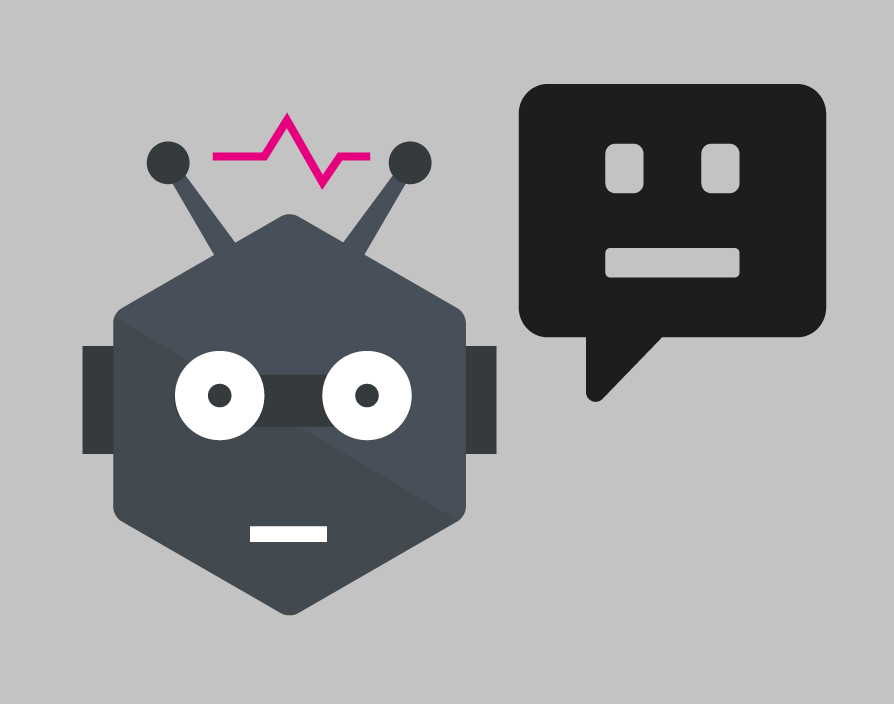At a recent chatbot meetup in London, delegates scribbled notes furiously as they heard about a Robbie Williams chatbot that cracks jokes and entertains fans. And for the first time, the number of marketers far outweighed the developers in the room. There’s a lot of buzz around chatbots at the moment – a survey by Oracle, the software company, found that 80% of respondents were already using or were planning to use them by 2020. But is now the time to invest? And are chatbots really smart enough to be welcomed into the inner circle of your marketing team?
Of course chatbots have been bobbing about since the internet’s early years, as anyone who remembers the AOL Instant Messenger chatbot SmarterChild will know. And given that we’re living in the age of nostalgia-drenched revivals, it seems natural that they’d make a comeback. But since they’ve evolved into many forms, defining what exactly a chatbot is can be somewhat tricky. Whether they communicate through an automated text message, Facebook Messenger or Amazon Echo, modern-day chatbots essentially deliver services via a chat interface. They’re usually powered by AI but not always. And they can respond to either voice or text commands. The trouble with such a loose definition, however, is that it makes the term prone to overuse. “Marketers have a tendency to latch onto a word and hammer it out until people are sick of it,” says Lawrence Weber, managing partner at Karmarama, the communications agency. “There’s a danger of pigeonholing some of these technologies.”
What’s perhaps getting marketers most excited is the potential chatbots offer for deeper engagement and more personalisation. “Some chatbots are behaving like very personalised search engines but with a more human touch and I believe that’s where they’ll go,” says Michael Olaye, chief technology officer at Dare, the digital agency. Many of the leading tech companies are even going that extra step and providing services that act as your very own Jeeves: making bookings, suggesting what to buy your brother for his birthday or reminding you to pick up your dry cleaning. Mark Zuckerberg has even developed a Facebook Messenger bot-ler for himself that helps him round the house, from popping on a round of toast to controlling the lights.
One arena where brands particularly want to boost engagement is social media. But time-pressed social-media managers can struggle to keep up and, according to Sprout Social, the social-media management tool, 89% of messages get ignored while it can take as long as 10 hours to respond to the other 11%. It’s tempting to see chatbots as an alternative. In January 2016, Chris Messina, a developer who’s known for having invented the hashtag, excitedly predicted in a blog that “2016 will be the year of conversational commerce” and we would all find talking to brands via chatbots totally normal by the year end.
While his vision might have been premature, several brands have launched chatbots that are able to hold a basic conversation, share suggestions for products and even entertain. Last year Channel 4 created a Facebook Messenger chatbot to promote the TV programme Humans while Odeon came out with a chatbot that gives people tailored film recommendations. Doing this with people rather than AI for all of Odeon’s customers would have been pretty much impossible, both logistically and financially.
Beyond just the discovery or engagement stages of the journey, chatbots can be just as effective at closing the deal and maintaining a rapport after a sale. Facebook Messenger allows transactions to take place within chats and Olaye believes they have a role to play after a sale or event too. “If you look at loyalty programmes, chatbots could help brands execute them by sharing relevant rewards,” he says. “There’s so much potential for brands to use the technology to establish lasting relationships.”
But if chatbots are going to really connect with consumers, it’s important that they convey the right personality so the experience isn’t jarring. “Because you’re removing the usual interface and buttons, the copywriter has a huge role to play when it comes to creating the script that’s behind the chatbot,” says Weber. “We need to fundamentally rethink user experience and your copy team needs to work closely with your developers.”
Even with a great script, though, chatbots are not always sophisticated enough to pick up on the nuances of the English language. Many chatbots are painfully slow and have trouble answering certain questions. Juraj Pal, co-founder of Sure, a bot that makes food and drink suggestions, programs bots so they can mimic natural language patterns and tailors the tone of the bot to mirror the way millennials speak by using emojis, GIFs and certain phrases or sentence structures. “While chatbots with in-built natural language processing is the dream, for now the power of your copywriting and storytelling is what makes the difference,” he says. “A lot of bots claim to have a certain personality but they can’t always stay in character when they encounter certain phrases.”
Pal is referring to the now infamous incidents where people have deliberately tried to game bots into making gaffes in an effort to test the boundaries of the technology. The most notorious example is Microsoft’s Tay chatbot, which was designed to learn from the tweets it received but was manipulated into spouting conspiracy theories and praising dictators. In light of this, it’s important for humans to be on hand to set things back on course when consumers attempt to derail the AI. “Early adopters like to try to break tech but developers are constantly learning and adding elements to overcome this,” says Pal.
And given the public’s penchant for trying to get AI to behave naughtily, Olaye advises marketers to avoid deploying them in particularly sensitive situations. “Chatbots aren’t foolproof so I wouldn’t recommend a brand uses them when people are already starting out dissatisfied and an issue needs to be diffused,” he says.
So until chatbots become smarter, brands should be aware of their limitations and set expectations for consumers. “I’ve been pleased to see that most brands have learned from previous tech where they over-promised,” Weber notes. “Chatbots are most effective for two things: conveying useful information or creating frivolous and silly entertainment to delight and surprise.” Weber believes marketers need to think long and hard about what a chatbot can do that an existing platform can’t – or run the risk of overwhelming the customer.
There’s another dimension to chatbots that marketers must consider: their responsibility when it comes to data. While there are clear policies around how brands use cookies to paint a picture of their customer, with a bot they’re asking people a range of intimate questions about their preferences and location. Brands need to be mindful that they’re doing their due diligence when it comes to telling people how they collect, store and use data or the public will soon grow wary of opening up to bots. “While millennials are comfortable using chatbots and sharing data, if you misuse their data it can damage your brand pretty quickly,” warns Olaye. “As chatbots become smarter and start to talk to each other, marketers need to consider the ethics.”
Data capture opportunity gone wrong or meaningful engagement tool: it’s up to marketers to decide how chatbots will be used. ![]()
Share via:


















































